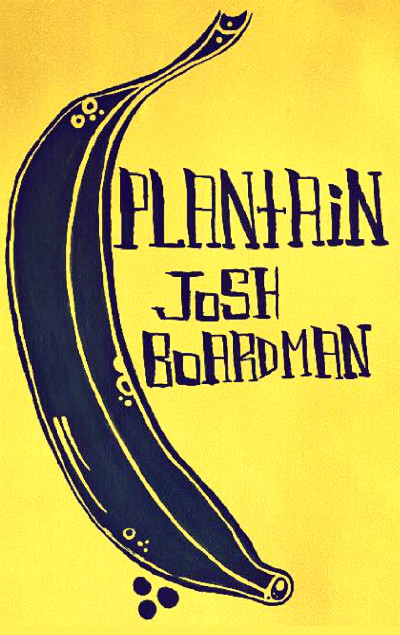
We’re pleased to present an excerpt from Josh Boardman’s new chapbook Plantain, available now from West Vine Press. Boardman’s book takes 25 distinct views of that most delicious of fruits, the plantain. Here are three short excerpts from the book.
***
This golden plantain. The wood of the table is rosy knotwood with grain swirling like starry night—the plantain like a planet sweeps from stem to end in a few dark highways and irony sideroads spinning cul de sacs. Beneath the topography the leather appears dun gold like a sprawling field of wheat. Sunbaked and waving. Food grows there. A person drew that driveway. Her family lives in the farmhouse. So with the plantain—this nick on the belly developing over time scorched a wedge around its two pineapple impression lines. Darker and darker roads fray from one extremity of the body to the other. Someone stiffwristed drives these highways. The stem lightens the woody hairs form a tough weave and nearly every hill and valley spreads something white over its own stake. Life lives here. What laws of gravity for a celestial body in the shape of a bent cylinder what atmosphere exhaled around it? What elements comprise its body? Does it shelter the people who live there? Or like the outer planets does it gape wide to the void of outer space?
***
Here is the plantain. All stem and tip. Which are brown wood with heavy shades of red earth looking like the crest and tailfeathers of some sooty cockatrice. The plantain slumps over in wrinkles crags a humpback and an eye bled with mold. The shadow grades in ripples till it flops forward onto the table. A thick petty shadow. Even darker than the not dark body. Greyish. The bobtail cricks to a point like it snapped and healed not quite right. But for all of that ugliness decay rot degeneration the plantain is exceedingly soft so soft in fact that ruts develop from the weight of just sitting. The back is musky with banana musk spots of mahogany blotted on top. A run the whole length of the stocking and a faint caucasian color peeks through. At the joining of the long neck to the body there is one final trace of days gone by—four patches of tired yellow the last feathers left around the neck. Hardly catching the light. Hardly brighter than the advanced periods of grey. Picture a deep urinary yellow dropped down in the dirt and rolled in dust. That yellow shows in the eye so small of the stem—a flash of recognition in a pockmark full dark.
***
There’s the plantain on its tower of books. Its skin full dark even its ruddiness fades to an adjacent shade of grey. The stem blends without boundary into peel the only differently shaded limb is the branchshorn end that once linked arms with the plantain’s bundlemates. It is the color of a living tree green hairy and knotted. A silk extends along the cragging wrinkles to the opposite tip where it distends in an organic dome as though propelled outward by the force of its own momentum. The regular wrinkleprint is not deep it occupies maybe seven wavelengths per centimeter but there is a broader formation that varies from peak to trough by a full centimeter and occurs only irregularly once per lateral inch. These greater waves twist unexpectedly from the ridge of one panel into the middle of the next sometimes dropping so precipitously that the slope inverts in overhang. These two variations make the peel tough in its most deathly and brittle state like a tube of cured leather. The nicks and scratches once striving for access to the meat have been pushed out out and out until even their coloring fades. This little plantain sits atop its tower like a citadel.
Follow Vol. 1 Brooklyn on Twitter, Facebook, and sign up for our mailing list.
